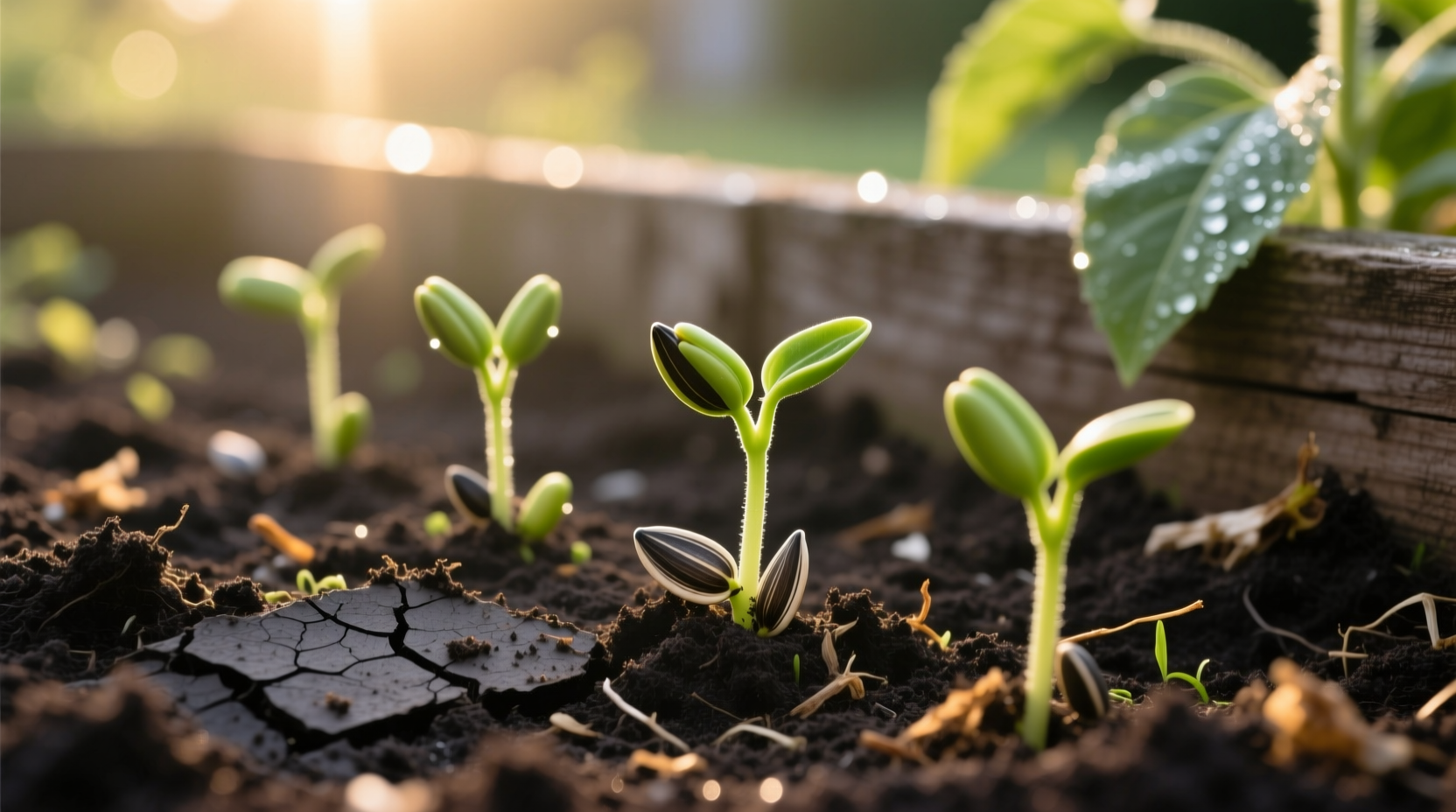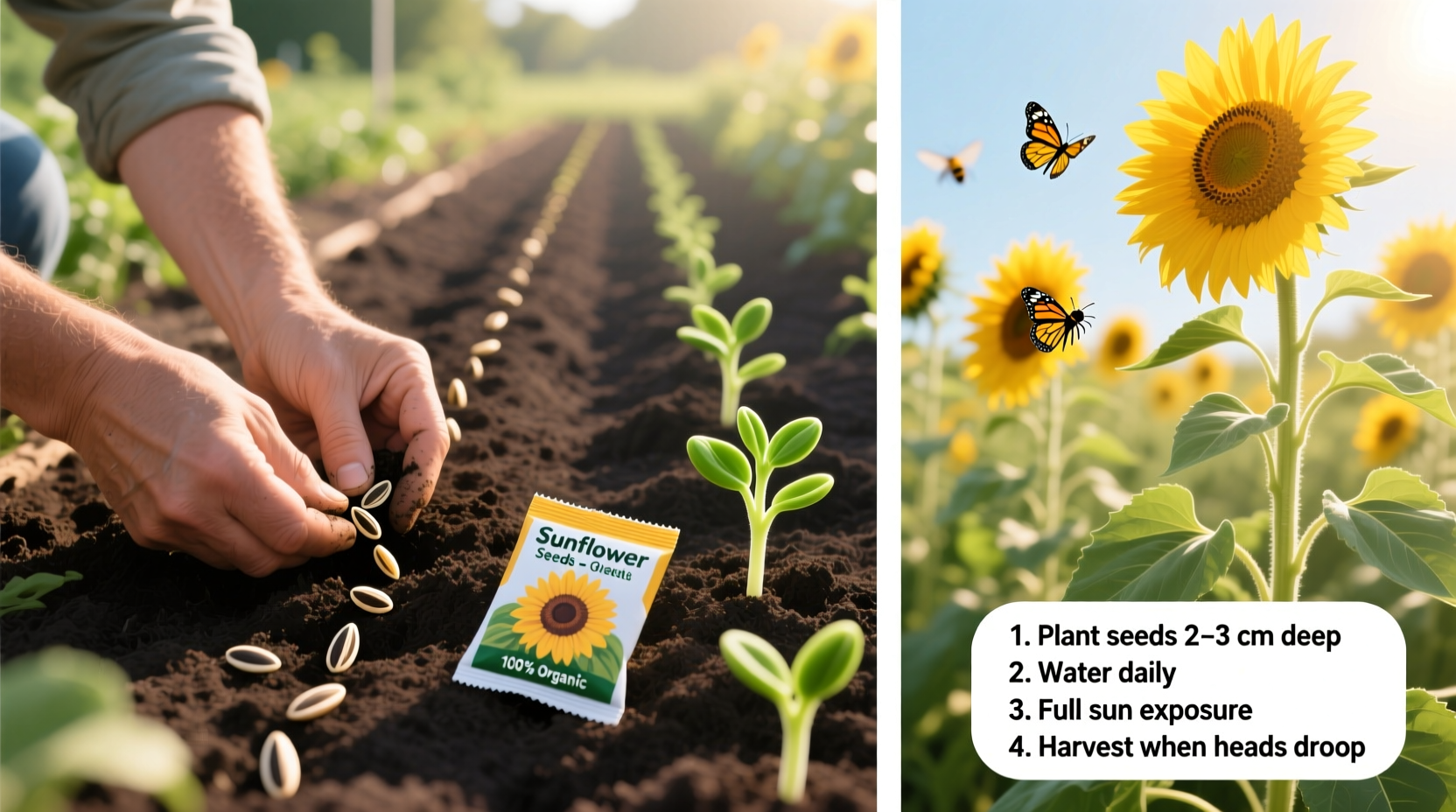Plant sunflower seeds 1-2 inches deep in well-draining soil after last frost when soil reaches 50-60°F (10-15°C). Space seeds 6-12 inches apart in full sun locations receiving 6-8 hours of direct sunlight daily. Water consistently to keep soil moist but not soggy during germination, which typically occurs in 7-14 days. For best results, choose disease-resistant varieties suited to your climate zone and prepare soil with compost before planting.
Your Complete Guide to Growing Sunflowers from Seed
Nothing brightens a garden quite like sunflowers, with their cheerful faces following the sun across the sky. Whether you're growing them for seeds, cut flowers, or simply for their beauty, starting from seed is the most rewarding approach. This guide provides proven techniques used by experienced gardeners to ensure your sunflowers thrive from planting through harvest.

Planning Your Sunflower Success
Successful sunflower growing begins with proper planning. The timing of your planting dramatically affects your results, as sunflowers are warm-season annuals that won't tolerate frost. Most gardeners make the mistake of planting too early when soil is still cold, which leads to poor germination or rotting seeds.
| USDA Hardiness Zone | Optimal Planting Window | Soil Temperature Minimum |
|---|---|---|
| 3-4 | Mid-May to early June | 55°F (13°C) |
| 5-6 | Early to mid-May | 50°F (10°C) |
| 7-8 | Mid to late April | 50°F (10°C) |
| 9-10 | March to early April | 50°F (10°C) |
This planting timeline comes from research by the University of Minnesota Extension, which has tracked optimal planting conditions across North America for decades. Your exact timing should be adjusted based on your local last frost date and current weather patterns.
When selecting varieties, consider both your purpose and space constraints:
- For seed production: Choose mammoth varieties like 'Mammoth Russian' or 'Giganteus' that produce large seed heads
- For cut flowers: Opt for branching varieties like 'ProCut' series that produce multiple blooms
- For small spaces: Dwarf varieties such as 'Sunspot' or 'Teddy Bear' work well in containers
Preparing the Perfect Planting Site
Sunflowers thrive in locations that receive full sun—meaning at least 6-8 hours of direct sunlight daily. They're called sunflowers for a reason! Choose a spot protected from strong winds, especially if growing taller varieties that can reach 10-12 feet.
Soil preparation is crucial for healthy sunflower growth. While sunflowers aren't particularly fussy, they perform best in well-draining soil with a pH between 6.0 and 7.5. Before planting:
- Clear the area of weeds and debris
- Loosen soil to a depth of 24-30 inches (sunflowers develop deep taproots)
- Mix in 2-3 inches of compost or well-rotted manure
- Avoid high-nitrogen fertilizers which promote leafy growth at the expense of flowers
The Penn State Extension notes that sunflowers actually perform better in moderately fertile soil rather than overly rich conditions, which can lead to weak stems and excessive foliage.
Planting Sunflower Seeds Correctly
Whether planting directly in the ground or starting seeds indoors, proper technique ensures strong germination and healthy seedlings:
Direct Sowing Outdoors
- Plant seeds 1-2 inches deep (deeper in sandy soils, shallower in clay)
- Space seeds 6 inches apart for dwarf varieties, 12 inches for standard types
- Water gently but thoroughly after planting
- Cover with a light layer of mulch to retain moisture
Starting Indoors (for short-season climates)
Start seeds in biodegradable pots 2-3 weeks before last frost date. Sunflowers don't transplant well due to their taproot, so use pots that can be planted directly in the ground. Plant seeds 1 inch deep in seed starting mix and keep soil consistently moist at 70°F (21°C) until germination.
When transplanting, bury the stem up to the first set of true leaves to encourage stronger root development. Water thoroughly after transplanting and provide temporary shade for the first few days to prevent transplant shock.
Nurturing Your Growing Sunflowers
Once established, sunflowers are relatively low-maintenance, but proper care ensures the best results:
Watering Requirements
During germination and early growth (first 3-4 weeks), water regularly to keep soil consistently moist but not waterlogged. Once established, sunflowers are moderately drought-tolerant but will produce larger flowers and seeds with consistent moisture. Water deeply 1-2 times per week rather than frequent shallow watering.
Fertilizing Strategy
Sunflowers don't require heavy feeding. Too much nitrogen promotes leafy growth at the expense of flowers. If needed, apply a balanced, slow-release fertilizer when plants are 1-2 feet tall. For seed production, switch to a phosphorus-rich fertilizer as flower heads begin to form.
Pest and Disease Management
Sunflowers face several common challenges:
- Birds: Cover developing seed heads with mesh bags when petals begin to dry
- Aphids: Spray with strong water stream or use insecticidal soap
- Fungal diseases: Prevent powdery mildew by ensuring good air circulation
- Squirrels: Use physical barriers around seed heads as they mature
The Royal Horticultural Society recommends rotating sunflower planting locations every 3-4 years to prevent soil-borne diseases from building up.
Harvesting Sunflower Seeds Successfully
Knowing when and how to harvest makes all the difference in seed quality and viability:
Timing Your Harvest
Harvest when the back of the flower head turns from green to yellow-brown and the seeds appear plump. The petals will have mostly fallen off, and the seed shells will show their characteristic black and white stripes. This typically occurs 30-45 days after flowering.
Harvesting Technique
- Cut the stalk about 12 inches below the flower head
- Place heads in a paper bag or hang upside down in a dry, well-ventilated area
- Allow to dry for 1-2 weeks until seeds loosen easily
- Remove seeds by rubbing your hand across the seed head
- Spread seeds on a tray to dry for additional 3-5 days
For immediate consumption, rinse harvested seeds and roast with your favorite seasonings. For planting next season, store completely dry seeds in an airtight container in a cool, dark place.
Troubleshooting Common Sunflower Problems
Even with proper care, you might encounter these issues:
Poor Germination
If seeds aren't sprouting, check these factors:
- Soil temperature below 50°F (10°C)
- Seeds planted too deep (more than 2 inches)
- Overwatering causing seeds to rot
- Old seeds with low viability (sunflower seeds remain viable for 4-6 years)
Weak or Leggy Growth
If plants are tall but weak with sparse flowers:
- Insufficient sunlight (less than 6 hours daily)
- Over-fertilization with nitrogen
- Crowding (not enough space between plants)
Dropping Flower Heads
If flower heads bend or break before maturity:
- Insufficient water during flower development
- Lack of support for heavy-headed varieties
- Nutrient deficiency, particularly potassium
Maximizing Your Sunflower Success
For gardeners looking to take their sunflower growing to the next level, consider these advanced techniques:
- Succession planting every 2-3 weeks for continuous blooms throughout summer
- Interplanting with companion plants like beans, squash, or herbs
- Using sunflowers as a natural trellis for climbing plants
- Collecting pollen to hand-pollinate for larger seed heads
Remember that sunflowers aren't just beautiful—they improve soil health by breaking up compacted earth with their deep roots and can even help with phytoremediation of contaminated soils, as documented by research from the USDA Agricultural Research Service.











 浙公网安备
33010002000092号
浙公网安备
33010002000092号 浙B2-20120091-4
浙B2-20120091-4